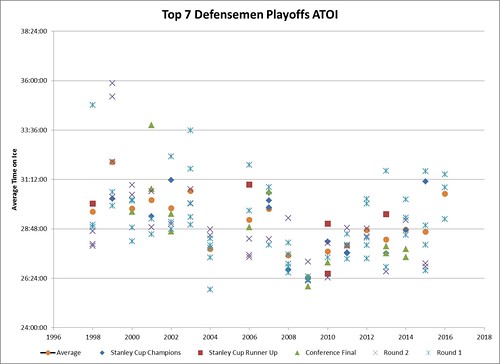When making my round 2 picks, I choose the Islanders as I thought the Lightning were simply too injured. Aside from Stamkos, I thought the injury to Stralman would prove too much for the Lightning’s defense; I did not think that Hedman would be able to put up big minutes like he did in round 1. Hedman averaged 27 minutes in round 1, and in game 5 it looked like it was starting to show with some poor puck possession and turnovers. However, he averaged 27 minutes ice time in round 2, and he was one of the key factors for their success.
Logging those types of minutes is now seemingly commonplace for a top defenseman in the NHL. There seems to be a shift to valuing – or almost needing – a workhorse type of defensive player on a team. Or, at least it feels that way: Pietrangelo, Letang, Josi – among others – are all logging Iron Man type of minutes in highly physical and emotional series. Looking at last year’s playoffs, Duncan Keith was seemingly never off the ice. Is it really different, or is it just that we hear about it more?

Looking at the numbers, it’s pretty obvious that the ATOI of an elite defenseman is slowly shifting upwards from a low we saw back in 2009, when no defenseman even averaged above 28 minutes per game. However, the numbers from the pre-lockout era show that defensemen used to be playing upwards of 31 minutes per game. The main difference seems to be that with the exception of Nicklas Lidstrom in 2002, no Stanley Cup winning team had had a defenseman average above 31 minutes. Duncan Keith surpassed that number last year, and based on the numbers it seems that this is a trend that is going to continue this year.
Prior to the lockout, the Stanley Cup winning team had a defenseman in the Top 7 skaters ATOI 3 out of 7 times, with Sergei Zubov’s of the Stars winning in 1999, Rob Blake’s Avalanche in 2001, and Nicklas Lidstrom’s Red Wings in 2002. More often than not, before the lockout having to play one defenseman was a sign of a team lacking depth.
Fast forward to post-lockout, and we’ve seen this happen 6 out of 10 times. Teams are playing their superstar defensemen more minutes, and it is currently trending upwards. No longer is it a sign of a shortened postseason run, but it is becoming a necessity to have a guy that can play 28+ minutes per game. Duncan Keith and Drew Doughty are the most recent to log heavy minutes on the way to the Cup.
A number of factors could attribute for this trend. One key influence is the importance of defense to win games. Wayne Gretzky even lamented this recently, stating “[a]ll in all, it’s sort of a grinding game now. You’re taught from Day 1 that your role and responsibility is to keep the puck out of your net.” The game and rules today favor teams with a stronger defense. Another cause could be the NHL expansions occurring faster than the talent pool can grow. This isn’t to say that the talent pool isn’t growing, but it is important to note that growing the sport doesn’t happen overnight. Finally, the salary cap has put constraints on how a team can be built. Having depth comes at a price.
We saw it this year with the Blackhawks; a team that had been questioned about its depth throughout the season. After being eliminated in the first round, it could be said that relying on this style of defenseman is not sustainable. Eventually, the lack of depth does catch up to a team. Historically speaking, the average TOI reached a peak and then progressed back down. I don’t think we have reached the peak yet, as we are still seeing that having this type of defensive player has a role in Stanley Cup caliber teams. All teams in the second round had at least one player averaging over 25 minutes of ice time: three of those teams have players averaging over 28 minutes. While it is working now, eventually it will change.
One way I could see this changing is a shift from high TOI to more offensive-minded defensemen. A lot of talk is always surfacing about the league wanting higher scoring games. Depending on how the league adapts and changes the rules to make this happen could change the importance of this type of workhorse defenseman to be able to put up more points.
About Jillian:
Jillian Fisher is a sport anthropologist who focuses on sport culture and fan culture. Growing up with three older brothers, sports have always played a large part of her life. While she enjoys all sports, hockey has always been her first passion. Jillian has traveled across the world - from the Philippines to Italy and across the US - studying the impact of sports, all while cheering for the home team and discovering what makes each place so unique, even being referred to as the Anthony Bourdain of sports. She is currently filming her own web series, Out of the Park, that highlights the different cultures surrounding our favorite sports across the country. Always in search of the next event, Jillian can be contacted on Twitter, Instagram, or emailed at jillianfisher00[at]gmail.com 